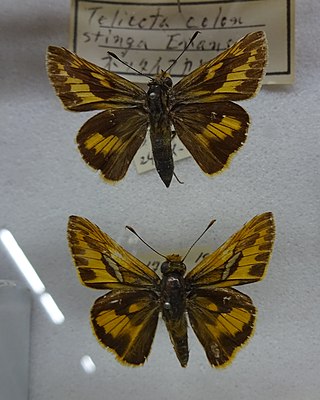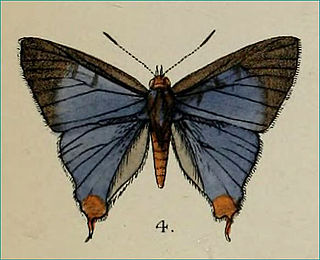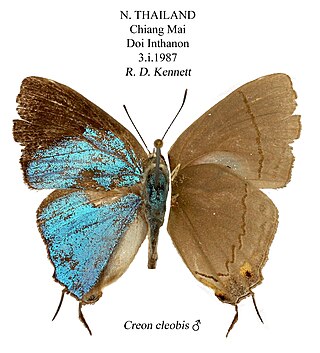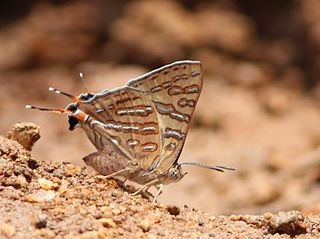
Telicota colon, commonly known as the pale palm dart or common palm dart, is a butterfly belonging to the family Hesperiidae found in India to Australia.

Chilades parrhasius, the small Cupid, is a small butterfly that belongs to the lycaenids or blues family. It is found in Nepal, southern Turan, southern Ghissar, Iran, Afghanistan, Pakistan, Sri Lanka, United Arab Emirates, Oman and southern, central and north-west India.

Ionolyce helicon, the pointed lineblue, or bronze lineblue, is a small butterfly found in the Indomalayan realm that belongs to the lycaenids or blues family.

Amblypodia anita, the purple leaf blue or leaf blue, is a lycaenid or blue butterfly found in South Asia and Southeast Asia, including Sri Lanka, India, Myanmar, Malaysia, and Java. The species was first described by William Chapman Hewitson in 1862.

Arhopala abseus, the aberrant oakblue or aberrant bushblue, is a species of lycaenid or blue butterfly found in Asia.

Arhopala centaurus, the centaur oakblue or dull oakblue, is a species of lycaenid or blue butterfly found in India and southeast Asia to the Philippines.

Zinaspa todara, the silver streaked acacia blue, is a species of lycaenid or blue butterfly found in South Asia.

Cigaritis abnormis, the abnormal silverline, is a species of lycaenid or blue butterfly found in south India and Pakistan.

Zesius chrysomallus, the redspot, is a species of lycaenid or blue butterfly found in Sri Lanka and India.

Pratapa deva, the white royal, is a lycaenid or blue butterfly found in the Indomalayan realm. The species was first described by Frederic Moore in 1857.

Tajuria jehana, the plains blue royal, is a species of lycaenid or blue butterfly found in Asia.

Tajuria cippus, the peacock royal, is a species of lycaenid or blue butterfly found in the Indomalayan realm.

Horaga onyx, the common onyx, is a species of lycaenid or blue butterfly found in Asia.

Hypolycaena nilgirica, the Nilgiri tit, is an uncommon species of lycaenid or blue butterfly found in Asia, especially in the lowland regions to mid-hills of India and Sri Lanka.

Deudorix perse, the large guava blue, is a species of lycaenid or blue butterfly found in the Indomalayan realm. It was described by William Chapman Hewitson in 1863. The larva feeds on Randia dumetorum.

Rapala lankana, the Malabar flash, is a species of lycaenid or blue butterfly found in South India and Sri Lanka. It was first described by Frederic Moore in 1879.

Thoressa honorei, commonly known as the Madras ace, is a skipper butterfly belonging to the family Hesperiidae found in south India.

Zeltus is a butterfly genus in the family Lycaenidae, the blues. It is monotypic containing the species Zeltus amasa, the fluffy tit, a small butterfly found in Indomalayan realm. The butterfly is found in India, specially the Western Ghats, Sikkim to Assam. It can also be found in Myanmar, Thailand, West Malaysia, Sumatra, Borneo, Java and the Philippines.

The broadtail royal is a butterfly in the monotypic genus Creon, in the family Lycaenidae. It is found in South Asia.

The Common shot silverline, Cigaritis ictis, is a species of lycaenid butterflies. It is native to India and Sri Lanka. The Sri Lankan population is classified as a subspecies: Cigaritis ictis ceylonica(Felder, 1868).




















